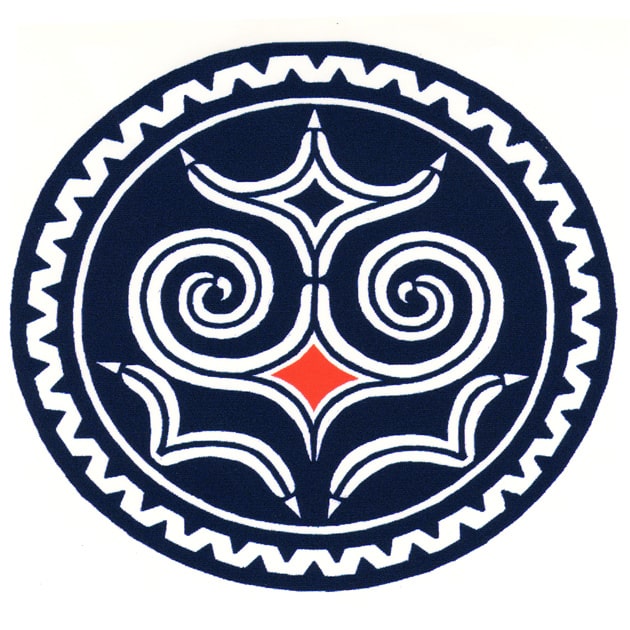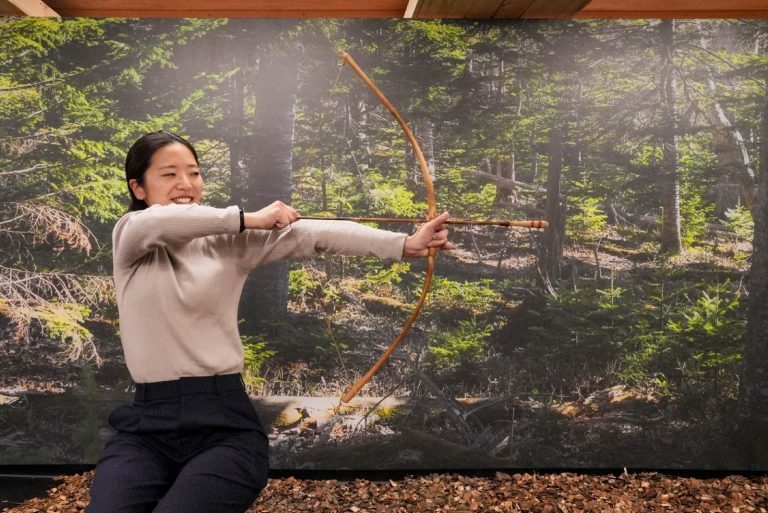Ainu People
The Ainu are the Indigenous people of Japan, particularly in Hokkaido. They possess a distinct language, deep respect for nature, and unique cultural traditions passed down through generations.
Location
Indigenous people mainly living in Hokkaido, Sakhalin, and the Kuril Islands.
History
From around the 13th century, the Ainu engaged in trade with the Japanese (Wajin).
During the Edo period, Japanese expansion into Hokkaido altered Ainu life.
After the Meiji era, assimilation policies caused a decline in Ainu language and culture. Today, there is an active movement to revive and preserve their heritage.
Culture
Animistic beliefs (Kamuy worship), traditional textiles (attus), woodcraft (inau, nipopo dolls), dance (rimse), and the bear sending ceremony (iomante) are key cultural elements.
Modern Day
"Upopoy" (National Ainu Museum) offering cultural experiences in Hokkaido.
Ainu Flag and Symbols

No official national flag exists for the Ainu people.
Symbolic designs often include
・Ainu patterns (Aiwushi, Moreu): Spiral and thorn motifs symbolizing protection from evil.
・Traditional clothing designs are sometimes used as symbolic emblems.
・Some modern groups use a blue, white, and red tricolor flag (inspired by historical Hokkaido symbols) as a unifying banner, but it is not officially recognized.
Language
The Ainu language is considered a language isolate, with no proven relation to any other language family. It once had multiple dialects across Hokkaido, Sakhalin, and the Kuril Islands.
Ainu Language Features
・Language Family: Isolate (no known relation to other languages).
・Phonetics:5 vowels (a, i, u, e, o), and relatively few consonants, similar to Japanese sounds.
・Writing:Traditionally an oral language; now written in Katakana or Roman letters.
・Characteristics:
・Verb-centered language.
・Uses verb conjugation instead of particles.
・Many place names in Hokkaido derive from Ainu (e.g., "Sapporo" = dry land).
Script
Traditionally oral, Ainu did not have a native writing system. Today, it is commonly written using katakana or Latin script for educational and preservation purposes.

Common Ainu Greetings and Phrases
| English | Ainu Language | Pronunciation |
| Hello | Irawankepte | irawankepte |
|---|---|---|
| Good morning | Itak (lit. "word") | itak |
| Thank you | Irankarapte | irankarapte |
| Nice to meet you | Kar si kur (lit. "I care for you") | kar si kur |
| Good night | Un ku rupu (lit. "I will sleep") | un ku rupu |
| Delicious | Hecuy | hecuy |
| Fun/Enjoyable | Kimoci yakan (lit. "It feels good") | kimoci yakan |
Region
Continent: Asia
Region: Japan (Hokkaido), Russia (Sakhalin, Kuril Islands)
Access Guide
The currency of the Ainu people is the Japanese Yen (JPY, ¥).
The currency shown here is the official currency (Yen) of Japan, where the Ainu people mainly live. Different currencies may be used in other countries.
Ainu Region
Example routes to the Ainu (Hokkaido/Sapporo/CTS) from major cities
| Departure City | Direct/Transit | Arrival Airport | Flight Time (approx.) | Reference Fare (one-way/round-trip, Economy) |
| Los Angeles | LA → Tokyo → Sapporo (New Chitose) | New Chitose (CTS) | About 14–17 hr | US$950–1,400 |
|---|---|---|---|---|
| New York | NY → Tokyo → Sapporo (New Chitose) | New Chitose (CTS) | About 15–19 hr | US$1,100–1,600 |
| London | London → Tokyo → Sapporo (New Chitose) | New Chitose (CTS) | About 15–20 hr | £850–1,400 |
| Tokyo | Tokyo → Sapporo (New Chitose) | New Chitose (CTS) | About 1 hr 45 min | ¥10,000–30,000 |
| Sydney | Sydney → Tokyo → Sapporo (New Chitose) | New Chitose (CTS) | About 13–16 hr | A$1,100–1,600 |
| Hong Kong | Hong Kong → Tokyo → Sapporo (New Chitose) | New Chitose (CTS) | About 8–11 hr | HK$4,500–6,800 |
| Shanghai | Shanghai → Tokyo → Sapporo (New Chitose) | New Chitose (CTS) | About 7–10 hr | CNY2,800–4,000 |
| Singapore | Singapore → Tokyo → Sapporo (New Chitose) | New Chitose (CTS) | About 11–15 hr | S$750–1,200 |
Language Origin
Ainu is a language isolate, meaning it has no confirmed genealogical relationship with other languages, although various hypotheses exist.
Traditional Games
The Ainu people have long enjoyed a variety of traditional games that reflect their deep connection to nature and community. These games were not only for fun but also helped develop physical skills and social bonds important for their hunting lifestyle.
Games like "Ikari-pa" (a ring toss using wood) and "Ukouk" (a bow-and-arrow game) reflect Ainu craftsmanship and nature-based play. Many toys were made using wood and animal bones.
1. Ikupasuy Throwing (Ikupasuy Ape)
・Description:Throwing a wooden prayer stick called "Ikupasuy" as far as possible.
・Purpose:To train arm strength and coordination useful for hunting.
・Cultural Context::The Ikupasuy is a sacred object used in rituals, and handling it in games teaches respect for nature and the divine.
2.Yukar Karuta (Storytelling Game)
・Description:Participants take turns reciting lines from Yukar (epic poems), continuing the story in rhythm.
・Purpose:Enhances memory and language skills.
・Cultural Context::A way to pass down oral traditions and legends through playful interaction.
3.Bow and Arrow Play
・Description:Using small bows and arrows to hit targets.
・Purpose:Develops aiming and focus, essential for hunters.
・Cultural Context:: Seen as a rite of passage for boys learning to become hunters.
4.Poro Rimse (Circle Dance Game)
・Description:Dancing in a circle while chanting and clapping in rhythm.
・Purpose:Builds a sense of unity and rhythm.
・Cultural Context::Celebrated during festivals and harvests to share joy and blessings.
Introduction video


Modern Revival and Experiences
・Workshops and cultural programs at places like Upopoy offer hands-on experiences of these traditional games.
・Some schools introduce Ainu games in cultural education, especially bow and arrow activities and storytelling.
Additional Notes
・Ainu games emphasize "experience," often taking place outdoors in harmony with nature.
・Through play, children learned respect for the environment and the importance of community cooperation.
